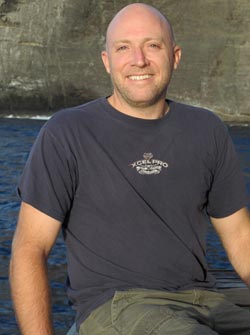
2011 Papahānaumokuākea Intertidal Monitoring Cruise Survey Team Reflections: Chris Bird – Hawaiʻi Institute of Marine Biology
My personal goal for this intertidal research cruise was to assess ʻopihi stocks, algal community composition, and the species richness of fish in the very nearshore shallow environment, and collect tissue samples for DNA analysis. As a research scientist, I've studied ʻopihi for 11 years, including connectivity of stocks across the archipelago, and their interactions with other organisms within the intertidal habitat. This year our intertidal surveys began from the highest intertidal organism on the rocks to 10-15 feet below the surface, which offers information about the connectivity of shoreline habitat.
At La Pérouse Pinnacles, Mokumanamana, and Nihoa Islands, we were able to collect data on ʻopihi densities in the absence of harvest. This information provides a fisheries management goal or benchmark by which to measure populations in the main Hawaiian Islands. It also helps us document what natural variation looks like and helps us understand what spatial scales the species should be managed by – ahupua'a, island, or archipelago?
We observed a decrease of intertidal diversity and ʻopihi start to look different from Kauaʻi to Gardner pinnacles, which poses some interesting questions - Is it because the larvae are not getting to those places or because populations are unstable because there's not enough habitat? Other notable observations include: ʻopihi were forming bands along the shoreline; some yellow foot 'opihi that were 8 cm long, something we never see in the populated islands; and a conspicuous absence of certain species, predator snails, anemones, bubble shells, and false ʻopihi. There were no shingle urchins on La Pérouse Pinnacles. In the very near shore we saw many of the same fish we see at home – surge wrasses, saddle wrasses, and lots of juveniles.
This is the third year of intertidal data for Papahānaumokuākea, and we are now seeing some change over time. For example, the high density of recruits that we saw in June 2010, didn't all survive. Basically, more ʻopihi settled on the shore than the habitat could sustain. In 2010 we saw lots of small one-month old ʻopihi (300 per m2), this year there was less 1.5 year old 'opihi (50 per m2).
My favorite moment was going on the island of Mokumanamana to collect the native moth, and to see the cultural sites and the perspective of the bay below and the carpet of Caulerpa algae – something we don't see at home. Mokumanamana feels like a very special place. Visiting these small islands and traveling to them by boat made me think how difficult it must be for larvae to find a place to land and grow.
If there is an opportunity in the future, I would like to come back and study the ʻopihi at La Pérouse Pinnacles. There are two different species but they are indistinguishable from each other and both occupy the same area of the intertidal zone.
Click Here for more Survey Team Reflections.
